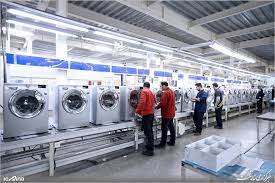Did you know the first toaster didn’t have a metal casing? Instead, it had an open design with two heating coils in the middle, and if you wanted to brown both sides, you had to flip it yourself. In addition to all of that, in 1905, when the first electric toaster hit the market, they cost the equivalent of $150 in today’s dollars.
Obviously, and thankfully, appliance manufacturing has come leaps and bounds over the past century. Today, we have smart toasters that can have your toast or pop tart ready when your morning alarm rings. Continue reading to learn more about appliance manufacturing.
Manufacturing machinery is more efficient than ever.
Appliance manufacturing requires high-capacity factory machinery. Some appliance manufacturers can produce thousands of washers and dryers per day.
With high-tech manufacturing tools like burn tables, also known as CNC plasma tables, manufacturers can make much sleeker and sharper cuts. No longer are large appliances merely objects of function within the household—they’re a work of art in their own right. Plasma and router tables allow machinists to make not only better cuts, but they’re able to work faster as well.
Customers want friendly, quick, and simple customer support.
The quality of the customer experience is one of the most key indicators of a company’s success in every industry, and appliance manufacturing is not the exception. If you thought the customer experience ended when consumers take your products home, you couldn’t be more mistaken. The customer journey lasts for the entirety of the life of the appliances they buy for you, and you should hope that’s a long time.
The best way to optimize your customer experience is to make customer support as accessible as possible. There are few things consumers hate more than waiting for customer service. We live in a hyper-busy society, meaning time spent waiting for customer support could’ve been spent doing other things, and consumers are keenly aware of this.
One of the easiest ways to lose customers forever is by giving them a lackluster customer experience. Your goal should be to make your customer support calls as friendly, quick, and simple as possible.
You should also have comprehensive customer service solutions available on your website and mobile app as well. You read that right—mobile app! You could even partner with a company like Virtual Appliance Repair to offer your customers virtual help with minor appliance troubleshooting and repairs.
With the assistance of the techs from Virtual Appliance Repairs, your customers will be able to handle many of the minor repairs themselves. Virtual repair assistance also allows you to provide coronavirus-safe repair solutions. To learn more about what virtual appliance repair is revolutionizing appliance maintenance, visit virtualappliancerepair.com.
The appliance industry is constantly changing.
As we covered in the introduction, appliances are worlds more advanced than they were 100, or even 20, years ago. It used to be enough for washers and dryers to be effective and durable, and now we expect them to be fast, energy-efficient, and smart.
The most important thing to know is that appliance manufacturing is ever-evolving. Not only are the top brands able to produce thousands of large appliances every day, but they’re improving their designs every day as well.
Not only are today’s appliances pushing the bounds of function and durability, but they’re also pushing the envelope aesthetically. In another 20 years, your drying machine will probably look like a miniature version of something you wouldn’t mind driving.
Safety is a top priority.
Even though appliances are more energy-efficient than ever, ovens, refrigerators, washers, dryers, and toasters use a lot of power. Over the decades, manufacturers have made dramatic improvements to the safety of their products. Furthermore, smart appliances have automatic shutoff features to prevent overheating when left unattended.
The top appliance manufacturers use high-tech tools to optimize the function and look of their products, prioritize customer service, and change with the times and needs of consumers. By the way, can you imagine what toasters will look like in another 100 years?













